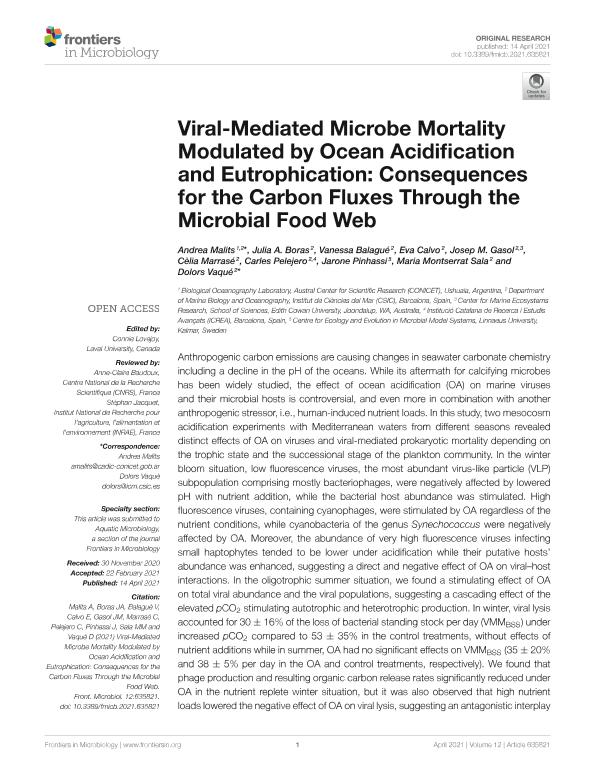Artículo
Viral-Mediated Microbe Mortality Modulated by Ocean Acidification and Eutrophication: Consequences for the Carbon Fluxes Through the Microbial Food Web
Malits, Andrea ; Boras, Julia A.; Balagué, Vanessa; Calvo, Eva; Gasol, Josep M.; Marrasé, Cèlia; Pelejero, Carles; Pinhassi, Jarone; Montserrat Sala, Maria; Vaqué, Dolors
; Boras, Julia A.; Balagué, Vanessa; Calvo, Eva; Gasol, Josep M.; Marrasé, Cèlia; Pelejero, Carles; Pinhassi, Jarone; Montserrat Sala, Maria; Vaqué, Dolors
 ; Boras, Julia A.; Balagué, Vanessa; Calvo, Eva; Gasol, Josep M.; Marrasé, Cèlia; Pelejero, Carles; Pinhassi, Jarone; Montserrat Sala, Maria; Vaqué, Dolors
; Boras, Julia A.; Balagué, Vanessa; Calvo, Eva; Gasol, Josep M.; Marrasé, Cèlia; Pelejero, Carles; Pinhassi, Jarone; Montserrat Sala, Maria; Vaqué, Dolors
Fecha de publicación:
04/2021
Editorial:
Frontiers Media
Revista:
Frontiers in Microbiology
ISSN:
1664-302X
Idioma:
Inglés
Tipo de recurso:
Artículo publicado
Clasificación temática:
Resumen
Anthropogenic carbon emissions are causing changes in seawater carbonate chemistry including a decline in the pH of the oceans. While its aftermath for calcifying microbes has been widely studied, the effect of ocean acidification (OA) on marine viruses and their microbial hosts is controversial, and even more in combination with another anthropogenic stressor, i.e., human-induced nutrient loads. In this study, two mesocosm acidification experiments with Mediterranean waters from different seasons revealed distinct effects of OA on viruses and viral-mediated prokaryotic mortality depending on the trophic state and the successional stage of the plankton community. In the winter bloom situation, low fluorescence viruses, the most abundant virus-like particle (VLP) subpopulation comprising mostly bacteriophages, were negatively affected by lowered pH with nutrient addition, while the bacterial host abundance was stimulated. High fluorescence viruses, containing cyanophages, were stimulated by OA regardless of the nutrient conditions, while cyanobacteria of the genus Synechococcus were negatively affected by OA. Moreover, the abundance of very high fluorescence viruses infecting small haptophytes tended to be lower under acidification while their putative hosts' abundance was enhanced, suggesting a direct and negative effect of OA on viral–host interactions. In the oligotrophic summer situation, we found a stimulating effect of OA on total viral abundance and the viral populations, suggesting a cascading effect of the elevated pCO2 stimulating autotrophic and heterotrophic production. In winter, viral lysis accounted for 30 ± 16% of the loss of bacterial standing stock per day (VMMBSS) under increased pCO2 compared to 53 ± 35% in the control treatments, without effects of nutrient additions while in summer, OA had no significant effects on VMMBSS (35 ± 20% and 38 ± 5% per day in the OA and control treatments, respectively). We found that phage production and resulting organic carbon release rates significantly reduced under OA in the nutrient replete winter situation, but it was also observed that high nutrient loads lowered the negative effect of OA on viral lysis, suggesting an antagonistic interplay between these two major global ocean stressors in the Anthropocene. In summer, however, viral-mediated carbon release rates were lower and not affected by lowered pH. Eutrophication consistently stimulated viral production regardless of the season or initial conditions. Given the relevant role of viruses for marine carbon cycling and the biological carbon pump, these two anthropogenic stressors may modulate carbon fluxes through their effect on viruses at the base of the pelagic food web in a future global change scenario.
Archivos asociados
Licencia
Identificadores
Colecciones
Articulos(CADIC)
Articulos de CENTRO AUSTRAL DE INVESTIGACIONES CIENTIFICAS
Articulos de CENTRO AUSTRAL DE INVESTIGACIONES CIENTIFICAS
Citación
Malits, Andrea; Boras, Julia A.; Balagué, Vanessa; Calvo, Eva; Gasol, Josep M.; et al.; Viral-Mediated Microbe Mortality Modulated by Ocean Acidification and Eutrophication: Consequences for the Carbon Fluxes Through the Microbial Food Web; Frontiers Media; Frontiers in Microbiology; 12; 4-2021; 1-19
Compartir
Altmétricas



